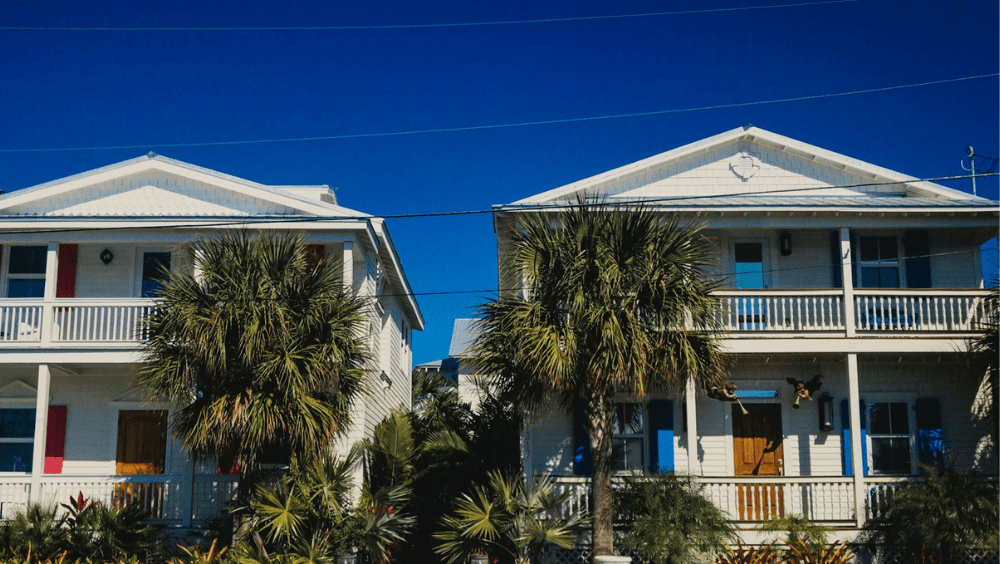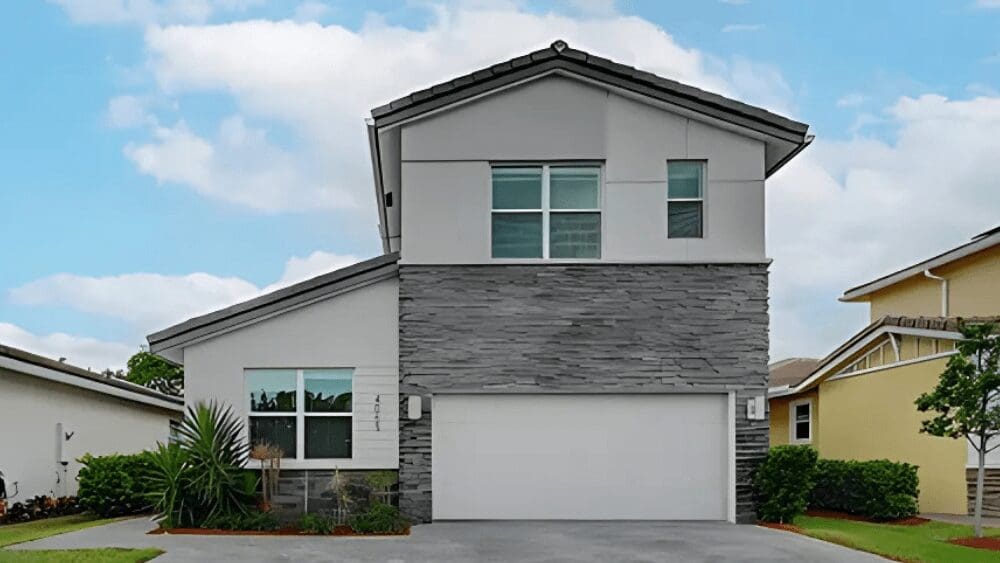
In recent decades, the U.S. has seen a blossoming interest in mobile homes, officially known after 1976 as manufactured homes. Statistics from Nebraska show a 226% increase in manufactured housing since 2009, and today a total of 22 million Americans live in these portable, prefab units. Packing a lot into an average 960 square feet, these structures offer cost savings, efficient living, and increasingly customizable designs. But if you’re one of these mobile home owners, you know the trade-offs. For one, you don’t have great appeal to impress guests or potential mobile home buyers if you ever decide to sell it. While a single-family home often exudes a welcoming aura naturally, a mobile home needs a little extra help in the looks department. Thankfully, there’s a lot you can do to counteract a mobile home’s boxy and boring exterior and disguise its semi-truck trailer design. This guide features advice on how to give mobile homes curb appeal by working with and around their unique structure. We’ll offer tips for getting started and provide a list of specific projects to inspire your next trip to the hardware store. You’ll be in love with how your mobile home looks in no time! Manufactured homes differ in a few key ways from traditional stick-built properties as far as rules and ownership, which could impact your curb appeal plans. Keep these details in mind before you purchase any paint or start planting trees: There’s a reason why manufactured homes cost about half the price of a single-family home of similar square footage: “In most mobile home parks, you own the trailer, but you’re just leasing the land,” explains Carl Young, a a top real estate agent in Knoxville, Tennessee. That means when the time comes to sell your mobile home, “you’re not selling real estate because you don’t own the land, which means we can’t put the listing in the MLS,” Young adds. If you don’t own the land itself, you may be limited on what you can do to your lot in terms of adding in-ground curb appeal — and it may even be the community’s responsibility to spruce up your landscaping at the very least. “Although, some of these homes are located in manufactured home subdivisions rather than managed communities, in which case the sellers do own the land,” says Young. “Those subdivisions often still have an HOA which may restrict what you can do in regards to curb appeal, but they’re usually pretty lax.” Check the curb appeal regulations put in place by your community’s property management company or HOA association. Every community is different, but most will have restrictions on decisions like: As long as your curb appeal plans adhere to your community’s guidelines it shouldn’t be too difficult to get approval. But you always want to get that approval before you lay out any money, in case the governing body of your community requests any modifications to the plans that will impact your budget. The biggest visual difference between manufactured homes and single-family houses is the lot size — and the positioning of the home on the lot. Single-family homes often have large, distinct, and separate front and backyards separated by a fence. They usually have the main entrance positioned on the front of the house, which is often longer than its sides. Manufactured homes are designed differently. Many have their entrances located on the side, granting direct access to the carport. Plus, mobile homes are almost always on long, lean lots, with the harrow side of the house facing the street. This means that both sides of your house are visible from the curb. So when you’re making your mobile home curb appeal plans, you can’t just think about sprucing up the front — you need to come up with a 360° design. With the above mobile home-specific curb appeal tips in mind, let’s take a look at seven specific projects to amp up the exterior appeal of your manufactured home. While manufacturers have come a long way toward improving mobile home exteriors with sleek, modern design elements, most homes in your community likely appear cookie-cutter. Dare to stand out with a new door featuring eye-catching details, like raised panels or 9-lite windows, to create a cozier welcome than the traditional metal mobile home door. You can get even more creative with your windows, adding custom shutters, flower boxes, and awnings in classic aluminum, retractable fabric, or durable solid awnings. The biggest, most dramatic curb appeal improvement you can make to any house is to rehab its exterior. If yours is sided with wood, aluminum, or fiber cement, you’re in luck: you can paint all three types for a dramatic makeover. You may just need to do some repairs to the outside of your mobile home first. We recommend that you: Then it’s just a matter of picking a paint color approved by your community. Because of their small stature, mobile homes are less expensive to paint. One mobile home owner did the project for $300 in 5 days with only two people helping. If your home has vinyl siding, its color is already infused into the siding material and it doesn’t take paint properly. In that case, a simple cleaning with a non-abrasive detergent and a soft-bristle brush should do the trick. If any of your vinyl has sustained damage, you’ll want to remove and replace any of the affected panels. The skirting on your manufactured home hides its cement pad foundation and pipes and keeps the underside of your house clear of snow, debris, and critters. It also makes a major visual statement. Skirting has certainly expanded beyond the traditional lattice or vinyl options. These days you can get polyurethane skirting that mimics faux bricks, stone, or rock that makes your mobile home appear as if it has more of a single-family home foundation. “I’ve seen some great skirting on manufactured homes so that I had no idea they were manufactured until I actually went inside, where you can always tell by the pitch of the roof,” says Young. Other options include decorative cinder blocks, metals like steel, or wood. Replacing your skirting will run you anywhere between $300 to $3,000, depending on the material you choose. Just make sure that you measure properly before purchasing so that you don’t run out. “Adding a deck to your entrance goes a long way. If you just have a staircase going up to the door, it makes it extremely obvious that it’s a mobile home,” explains Young. As a bonus, when you don’t have a big yard, a deck addition creates additional space to relax outdoors. You can also add an element of style with a pergola, a screen-enclosed sunroom, or an open air deck with built-in seating. For this type of project, plan to hire a construction crew familiar with adding decks or porches to mobile homes — or you could cause damage. Decks for manufactured homes must get their load-bearing support directly from the ground and not from any attachment to the home itself. If the deck is attached to the house, it puts stress on your home that can actually hurt your mobile home’s structure. In addition, get explicit permission from your community’s property manager or HOA for a deck or porch addition. Any build outs (even decks) usually require community approval, in part to ensure that your plans don’t put your deck or porch too close to the property line of your neighbor. In manufactured home communities, carports may be more popular than garages. While carports are great for providing shelter and shade, they typically consist of a thin metal roof supported by narrow aluminum poles, which are not known for being attractive. To dress up your carport, swap out chintzy narrow poles for scrolled metal supports or sturdy, substantial columns to improve curb appeal. You can also expand the size of your carport without replacing the roof by adding offset awning supports that add a modern look to your mobile home. Landscaping is one of the chief ways to create stand-out curb appeal for any home, including those of the mobile variety. But what are your options if you don’t actually own the land that your mobile home sits on? A few land-leasing communities may restrict what you’re allowed to plant and handle all the landscaping for you. Luckily, most allow you to plant freely in your small yard, even if you don’t technically own the land. You just need to choose greenery that can survive and thrive there. For example, you should avoid planting shrubs and trees too close to the home as the water they require can damage your siding and attract pests. Space limitations require that you also guard against trees and plants that have extensive, invasive root systems. Over time, tree roots in the wrong place will damage your plumbing and foundation. If you’re not careful, the problem could creep over to your neighbors’ properties as well. Going vertical is one way to maximize what little landscaping area you have, which you can do with small trees that have non-invasive root systems. Vines are another option to go vertical with your greenery, especially on carport supports. If you do decide to go with a climbing plant on your mobile home itself, make sure you choose a variety that won’t damage siding. No matter what you decide to plant, just make sure you run your gardening plans by your governing board before digging any holes so that you don’t violate any rules about planting near property lines. If you lease the land where your mobile home sits, your community may also be part RV park, too. That’s a great excuse to embrace the luxury camping vibe that RV life offers. While real estate is at a premium in a mobile home lot, many do have a small “backyard” area at the back end of the unit that too often remains empty and unused. You can change that pretty quick. One idea is to lay in some pavers, bricks, or flagstone to create a dedicated patio area. Then give your new patio a purpose: Add an outdoor table and grill for picnics, or build a firepit and put in some seating for evening campfires and s’mores. Most mobile homes have a boxy, cardboard cutout look, and live on long, lean lots that leave little room to make a curb appeal statement. Now you know, though, that there are great ways to add unique architectural details to your façade, get creative with your landscaping, and amp up your outdoor living space for curb appeal that rivals any other home, manufactured or not.Tips for any mobile home curb appeal project
1. Know what you own (and who’s responsible for its upkeep)
2. Get permission before you spend any money on repairs
3. Think 360° when making your curb appeal plans
How to enhance the exterior of your mobile home
1. Install a unique front door and matching architectural accents
2. Repaint or repair your siding
3. Spruce up the skirting
4. Replace plain steps with a porch or a deck
5. Get creative with your carport
6. Play around with plants
7. Maximize any outdoor living space
Spreading the curb appeal love to mobile homes



